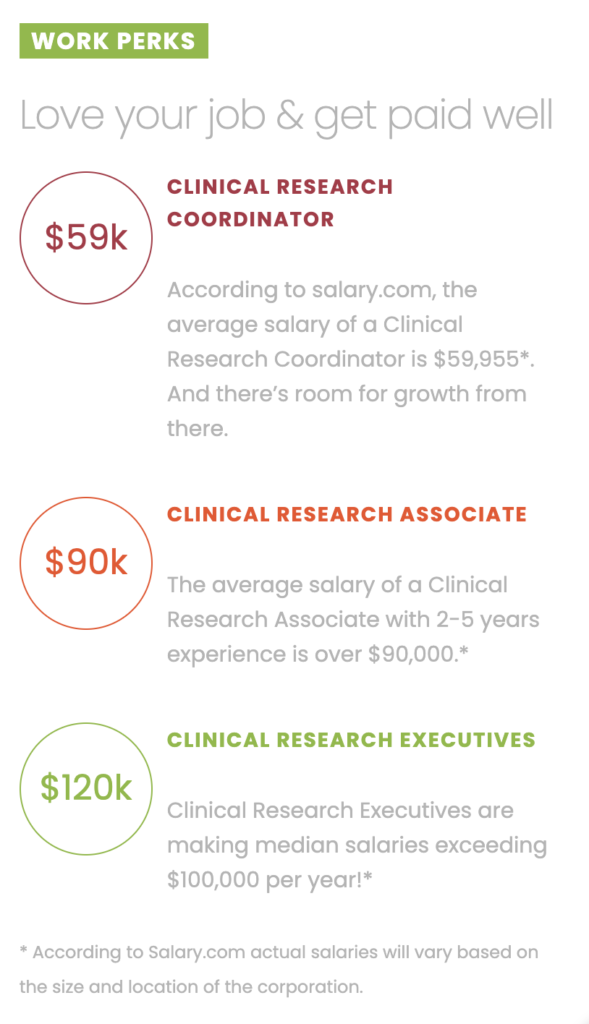INDUSTRY INFORMATION
The clinical trial industry is experiencing significant growth
Industries
THE PHARMACEUTICAL INDUSTRY
The global clinical trials market size was valued at over USD 47.0 billion in 2021 and is expected to expand at a compound annual growth rate (CAGR) of 5.8% from 2022 to 2030. This sector directly employs 810,000 people and the Pharmaceutical Research and Manufacturers of America estimate nearly 3.4 million jobs are induced by this industry.
Treatments for diseases such as cancer, heart disease, Alzheimer’s, stroke, diabetes and many other conditions that plague us today are being researched. The new remedies are tested in clinical trials and clinical research coordinators are needed to carry out the study. This sector is filled with opportunity and promise to create jobs and help us all live longer and healthier lives.
THE MEDICAL DEVICE INDUSTRY
The United States has the largest medical device market in the world, with more than 6,500 medical device companies in the U.S., according to Select USA. Medical device companies are located throughout the country, but are mainly concentrated in regions known for other high-technology industries, such as microelectronics and biotechnology. The states with the highest number of medical device companies include California, Florida, New York, Pennsylvania, Michigan, Massachusetts, Illinois, Minnesota and Georgia, as well as Washington, Wisconsin, and Texas. Arizona has several reputable device companies in the valley.
Investment in medical device research and development more than doubled during the 1990s, and research and development investment in the domestic sector remains strong. Collaboration with biotechnology, software and electronics firms have led to prolific advances in stent technologies, biomarkers, robotic assistance and implantable devices. The drive to innovate, research and discover better ways of treating and diagnosing medical problems, continues to stimulate growth in this sector.
WHAT IS A MEDICAL DEVICE?
- Popular areas of medical devices include:
- Electro-medical equipment: pacemakers, patient-monitoring systems, MRI machines, diagnostic imaging equipment and ultrasonic scanning devices.
- X-ray devices and other diagnostic imaging.
- Surgical and medical instruments: optical diagnostic apparatuses, blood transfusion devices, syringes, hypodermic needles, and catheters.
- Surgical appliances and supplies: such as artificial joints and limbs, stents, surgical dressings, and wheelchairs.
- Dental equipment and supplies: from instruments, to amalgams, to dental chairs.
BIOTECHNOLOGY
Modern biotechnology is changing our world. The industry provides breakthrough products and technologies to combat debilitating and rare diseases, reduce our environmental footprint, and create new efficiencies in our everyday lives. Clinical research coordinators are working on cutting-edge studies to improve healthcare and generate new options for patients all over the globe.
At least 250 biotechnology health care products and vaccines are currently available to patients and new treatments are being researched and developed. Recent advances in biotechnology are helping us cure diseases and save lives.
Biotech is helping to heal the world by harnessing nature’s own makeup to heal and direct lines of research. Biotechnicians are changing the odds of serious, life-threatening conditions affecting people around the world and now tailoring treatments to individuals to minimize health risks and side effects. Every new treatment must be tested in a clinical trial and every trial requires the support of clinical research coordinators. This field is exciting, growing and improving the lives of millions.
ACADEMIC AND GOVERNMENT RESEARCH
The National Institute of Health (NIH) invests $30.1 billion annually in medical research. The government is a huge supporter of clinical research and in the eyes of many should be investing much more.
Academic institutions around the United States and around the world are performing clinical research to develop new treatments and unlock the answers to important health questions. Academic Universities and other non-profits are competing with the private sector, developing new drugs and technologies and working on fascinating research. Often academic institutions and non-profits have more creative freedom to explore new ideas and look at fundamental breakthroughs. Researchers will often jump between the private and public sectors over the course of their careers. Working in either corporate clinical research or academic research can be rewarding, gratifying and lucrative.
In the field of clinical research options and opportunities abound. The field awaits talented individuals to help us develop cures and treatments to our health problems and to push scientific inquiry forward.

